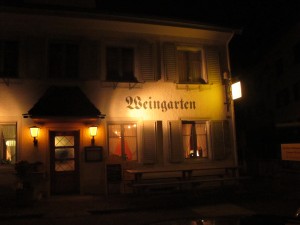 On a visit to friends, I had the honor of determining the wines of the evening. Selection: Some of the most interesting wines in the area (Canton Thurgau). Thurgau - located in the very northeast of Switzerland - is a small wine region even by Swiss standards and the wines are relatively little known. Here, agriculture is dominated by fruit growing; it's not for nothing that the canton is somewhat disparagingly, but also affectionately, called "Mostindien". But there are also almost 300 hectares of vineyards, mainly on the south-facing, gently sloping slopes, on the Islisberg, near Weinfelden, in the Thurtal, on the Untersee, in the Lauchtal... Probably the best-known winemaker in the area was Hans Ulrich Kesselring (sadly deceased in 2008), his winery is continued by a relative and is still considered a showpiece operation in eastern Switzerland. The average Swiss wine lover hardly knows much more. I was all the more curious about two vintners I knew only by name, Wolfer and Burkhart.
On a visit to friends, I had the honor of determining the wines of the evening. Selection: Some of the most interesting wines in the area (Canton Thurgau). Thurgau - located in the very northeast of Switzerland - is a small wine region even by Swiss standards and the wines are relatively little known. Here, agriculture is dominated by fruit growing; it's not for nothing that the canton is somewhat disparagingly, but also affectionately, called "Mostindien". But there are also almost 300 hectares of vineyards, mainly on the south-facing, gently sloping slopes, on the Islisberg, near Weinfelden, in the Thurtal, on the Untersee, in the Lauchtal... Probably the best-known winemaker in the area was Hans Ulrich Kesselring (sadly deceased in 2008), his winery is continued by a relative and is still considered a showpiece operation in eastern Switzerland. The average Swiss wine lover hardly knows much more. I was all the more curious about two vintners I knew only by name, Wolfer and Burkhart.
For the aperitif wine, I chose a Kernling from the Burkhart winery (Weinfelden). I admit, I was above all attracted by the grape variety. I have never drunk wines from the mutation of Kerner - the Kernling. There are only a few hectares that are planted with this new grape variety (bred in 1991, launched in 1995). I know the Kerner, but not the Kernling. Is it different? Better? The Kerner is already considered a specialty, especially here in Switzerland, because it usually has more acidity than the Riesling and - if you'll forgive me - is often fruitier, also more varied in its aromas. And the Kernling? It's a bit more idiosyncratic: the little wine round even said: more idiosyncratic than the usual aperitif wines. I chose well.
The wine was fresh, with a fine bouquet and an elegant finish. The citrus notes subtle, they even gave way to light oriental spices: saffron, baharat, pine nuts... Or am I fantasizing? In any case, it was a wonderfully differentiated taste experience for me. I can well imagine drinking this wine with fish. In any case, I find it more elegant, perhaps more pleasing (despite its own notes) than the Kerner and than the "Sequana" - opened for comparison purposes - from Weingut Wolfer (also Weinfelden) made from Pinot Noir grapes, Pinot gris and Sauvignon blanc. For me, the Kernling is a real surprise.